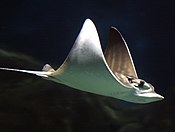Eagle ray
Appearance
| Eagle ray Temporal range: Late Cretaceous to Recent[1]
| |
|---|---|

| |
| Bull ray (Aetomylaeus bovinus) | |
| Scientific classification | |
| Domain: | Eukaryota |
| Kingdom: | Animalia |
| Phylum: | Chordata |
| Class: | Chondrichthyes |
| Subclass: | Elasmobranchii |
| Superorder: | Batoidea |
| Order: | Myliobatiformes |
| Suborder: | Myliobatoidei |
| Superfamily: | Dasyatoidea |
| Family: | Myliobatidae Bonaparte , 1838
|
| Genera | |
The eagle rays are a group of
cartilaginous fishes
in the family Myliobatidae, consisting mostly of large species living in the open ocean rather than on the sea bottom.
Eagle rays feed on
ovoviviparous, giving birth to up to six young at a time. They range from 0.48 to 5.1 m (1.6 to 16.7 ft) in length and 7 m (23 ft) in wingspan.[1]
Classification
Nelson's book Rhinopteridae and Mobulidae outside of the Myliobatidae.[2] White (2014) retained three genera (Aetobatus, Aetomylaeus, and Myliobatis) in the Myliobatidae, while a fourth (Pteromylaeus) was synoymized with Aetomylaeus.[2] A 2016 paper placed Aetobatus in its own family, the Aetobatidae.[3]
| Image | Genus | Species | Description |
|---|---|---|---|
 |
Aetomylaeus Garman, 1908 |
|
This obscure genus is distributed in the Eastern Atlantic Ocean, Indian Ocean, and Pacific Ocean. These rays were named because they lack a sting on the tail.[2] |
 |
Myliobatis Cuvier, 1816 |
|
The bat eagle ray , M. californica, in the Pacific Ocean. These rays can grow extremely large, up to 1.8 m (6 ft) including the tail. The tail looks like a whip and may be as long as the body, and is armed with a sting. Eagle rays live close to the coast in depths of 1 to 30 m (3 to 98 ft) and in exceptional cases, they are found as deep as 300 m (980 ft). The eagle ray is most commonly seen cruising along sandy beaches in very shallow waters, its two wings sometimes breaking the surface and giving the impression of two sharks traveling together.
|
